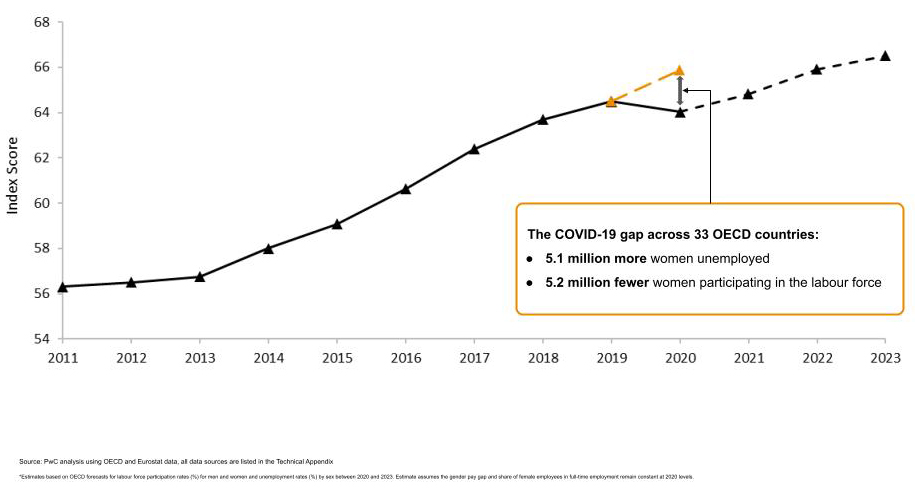PwC Releases ‘Women In Work Index’
Higher female unemployment and a greater proportion of women leaving the labour market due to the Covid-19 pandemic has “set back progress towards gender equality in work by at least two years, according to PwC’s latest analysis.”
A spokesperson said, “Higher female unemployment and a greater proportion of women leaving the labour market due to the COVID-19 pandemic has set back progress towards gender equality in work by at least two years, according to PwC’s latest analysis.
“PwC’s Women in Work Index, now in its tenth edition, assesses women’s employment outcomes across 33 OECD [Organisation for Economic Cooperation and Development] countries. After a decade of slow but consistent gains from women in work across the OECD, the Index fell for the first time in its history.
“The two main contributing factors to the Index decline were higher female unemployment and lower female participation rates during the worst of the pandemic. The Index estimates a “COVID-19 gap”, which compares job losses to the employment growth projected prior to the pandemic, finding there were 5.1 million more women unemployed and 5.2 million fewer women participating in the labour market than would be the case had the pandemic not occurred.
“Childcare and domestic work responsibilities played a significant role in causing women to leave the workforce. An OECD report on gender inequalities in caregiving and labour market outcomes during COVID-19 shows women took on more unpaid childcare responsibilities during the pandemic, causing them to leave the workforce at higher rates than men. Mothers were three times more likely than fathers to report taking on either the majority, or all, of the additional unpaid care work created by school or childcare facility closures.”
Megan Green, PwC Bermuda, Director and Inclusion & Diversity leader, said, “The pandemic has resulted in a set back for women and our goal of gender equality in the workplace. Whilst we have all felt the impact of the pandemic, women as a whole have shouldered a greater burden when balancing the increasing home requirements of child care and homeschooling and their role in the workplace.
“We need governments and businesses to address this consequence of the pandemic and to consider the needs of women and other disadvantaged groups. This is essential if we are to close the gap and improve gender equality in both work and society, and finally break the bias.”
The spokesperson said, “Women from ethnic minority groups are still more than a decade behind white women in terms of unemployment, and are proportionately worse off now than they were in 2011.” Ethnicity and gender pay penalty analysis shows that, in the UK, women from ethnic minority groups earn less than men from both White and Ethnic Minority groups and White women, based on [like-for-like comparison] of people working in the same occupations and with the same qualification levels.
“PwC’s Women in Work Index is based on five indicators that reflect women’s participation in the global labour market and equality in the workplace. Given the slow progress made over the past 10 years against each of the five indicators, and lost ground due to the pandemic, we estimate it will take years – in some cases decades – to close the gaps and achieve gender parity between women and men in the global workplace:
- Female labour force participation rate [33 years to match men’s current 80% rate]
- Female to male labour force participation rate gap [30 years to close the gap]
- Female unemployment rate [9 years to match men’s current rate]
- Female full-time employment rate [67 years to equal the current share of male employees in full-time employment]
- Gender pay gap [63 years to close the gap]
“Increasing women’s participation in the transition to net zero will be key to closing the employment gap.
“Effective policy action is needed to achieve greater gender equality in workplaces globally. This means more flexible working options, particularly that address the underlying gender inequalities in unpaid care and domestic work. Policies like equal paid parental leave that help to redistribute the unequal burden of care carried by women.
“Even more critical will be the need for government and business to support women to benefit from the job opportunities created by the transition of OECD economies to net zero. The next decade of work will be shaped to a large extent by the transition of economies to net zero emissions. Our analysis shows that the net zero transition will increase jobs overall, with more jobs in 2030 in 15 out of 20 sectors across the OECD economies.
“However, the largest proportional gains in jobs will be in utilities, construction and manufacturing, which are disproportionately underrepresented by women. These sectors currently employ nearly a third of the male workforce across the OECD, compared to only 11% of the female workforce.
“If nothing is done to improve women’s representation in these sectors, PwC estimates that the employment gap between men and women across the OECD – which measures the additional number of men in employment, expressed as a percentage of the number of employed women – will widen by 1.7 percentage points by 2030 [rising from 20.8% in 2020 to 22.5% in 2030].”



“Childcare and domestic work responsibilities played a significant role in causing women to leave the workforce. An OECD report on gender inequalities in caregiving and labour market outcomes during COVID-19 shows women took on more unpaid childcare responsibilities during the pandemic, causing them to leave the workforce at higher rates than men. Mothers were three times more likely than fathers to report taking on either the majority, or all, of the additional unpaid care work created by school or childcare facility closures.”
Yup. No surprise there.